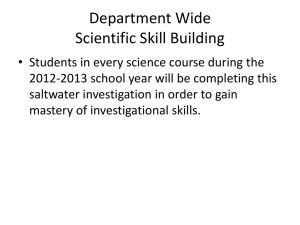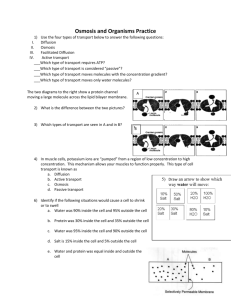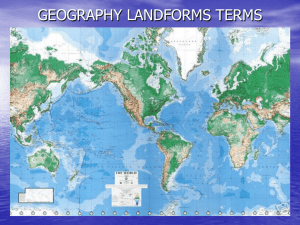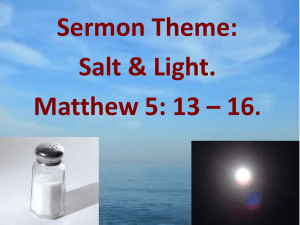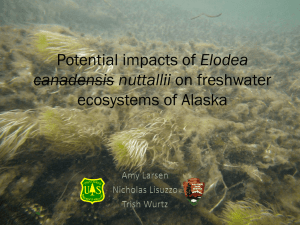3.1-IMS-Skills-LAB.ElodeaPlasmolysis
advertisement
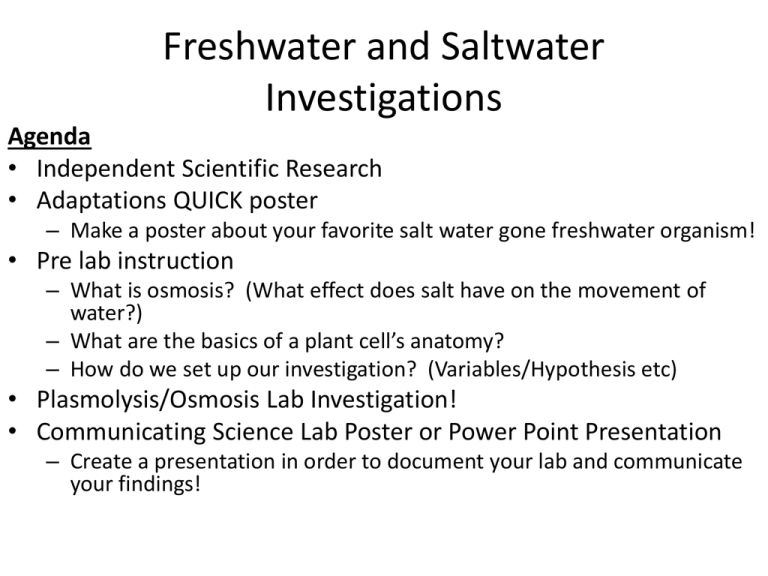
Freshwater and Saltwater Investigations Agenda • Independent Scientific Research • Adaptations QUICK poster – Make a poster about your favorite salt water gone freshwater organism! • Pre lab instruction – What is osmosis? (What effect does salt have on the movement of water?) – What are the basics of a plant cell’s anatomy? – How do we set up our investigation? (Variables/Hypothesis etc) • Plasmolysis/Osmosis Lab Investigation! • Communicating Science Lab Poster or Power Point Presentation – Create a presentation in order to document your lab and communicate your findings! Warm Up Independent Research Day 1. What affect does salt water have on organisms? 2. What is a dependent variable? 3. What is an independent variable? 4. What is a constant? 5. Write a hypothesis to this statement: Sam thinks that using bigger worms will help him to catch more fish. Engage: Do you recognize these aquatic organisms? The reading today will tell you why they are unique! Sardines, Stingrays, African Cichlids and Rare Freshwater Seals! Explore: Independent Scientific Research! Read About the Effects of Salt Water on Organisms Objective: Students will conduct independent research in order to describe the affect of salt water on aquatic organisms. Explain Sardines, Stingrays, African Cichlids and Rare Freshwater Seals! Extend & Evaluate What You Have Learned! Salt Water to Fresh Water Aquatic Organisms Poster • After conducting research (Fish formerly found in saltwater were forced to adapt to their new habitat) you will pick your favorite aquatic organism to make a poster. • Your poster must include: – Name of the organism – What is the organism’s relationship with salt water (past and present) – What is the organism’s relationship with freshwater (past and present) – Picture of the organism – Explain why fresh water and salt water have different effects on organisms (ask for help!) Plasmolysis Elodea Lab Investigation Objective: Students will create and test a hypothesis in order to determine the affect of salt on freshwater plants. Warm Up Pre Lab Instructions Day 1. What affect does salt water have on aquatic organisms? 2. Name 4 aquatic organisms that originated (started) in salt water and have adapted to fresh water. 3. Use the following statement A freshwater plant that was put in saltwater would shrivel up. A. Name the IV, constants and DV for this statement. B. Write a hypothesis for this statement. Engage: What is happening in this video? Watch closely! HINT: Think about the effect that salt water has on organisms! Explore: Independent Research Elodea Complete a power paragraph in order to describe the elodea plant. Explain: “Cell Movement Notes” Set Up Cornell Notes Under Your Power Paragraph on Elodea We have already gone over some of the basics… Let’s put it in writing to make sure you know! Osmosis- movement of water from high to low concentration. Water always moves toward a solute (example: salt). Basic Plant cell anatomyPlant Cell Wall-Tough Rigid outermost structure on plant cell. Cell MEMBRANE- Flimsy/soft layer that controls movement in and out of cell. CHLOROPLAST- Absorb sunlight to make sugar for the plant. Video On Osmosis How are these pictures different? What type of cells are they? These are elodea cells and YES they are different! You will find out why very soon! Extend and Evaluate Pre Lab Design • Read the “back ground” information • Ask questions! • Next, together, we will start planning out your – Variables – Hypothesis REMEMBER! The IVCDV chart is used to design an experiment. Be Ready to Start the Lab Tomorrow! Experiment Day • We will start by identifying the variables for this investigation. iv constants dv salt The variable (factor) that you will change is the independent variable. No salt These are the salt amounts varied by the experimenter. 5% salt solution 10% Salt Solution iv salt dv constants Cell Size (looking under microscope) No salt 5% Salt Solution 10% Salt Solution The variable (factor) resulting from the independent variable is the dependent variable. iv fertilizer constants amt. of water dv plant growth Scientist measuring water that must NOT These are the factors 2 drops 0 drops change during experimentation. They type of plant 4 drops must remain constant. 6 drops Source of light location Size of plant Warm Up Elodea Plasmolysis/Osmosis Lab Day! 1. 2. 3. 4. What are we investigating today? What was your hypothesis from yesterday? Name 3 ways that you will be safe today in the lab. What are the consequences if you do not meet expectations in the lab today? 5. What do you do in the lab if you have a question? RAISE YOUR HAND AND MAKE EYE CONTACT WITH THE TEACHER. YOU WILL BE HELPED IN THE ORDER THAT YOU ASK. CALL POLITELY IF NEEDED! Engage: What is happening to the Elodea cells in this video? Explore: What do you remember from the Pre Lab Instruction? •What conditions would make these cells swell up? •What are the green circles in the cell? •What is the tough outline around the cell? •What controls the movement of stuff in and out of the cell? Explain: Quick Demo/reminder on how to make a wet slide Extend: Begin the Lab! Evaluate: Turn in your lab reports! Make sure your lab report has: • Pictures for all 3 water solutions in both magnifications • Written observations • All prelab materials sorted out
